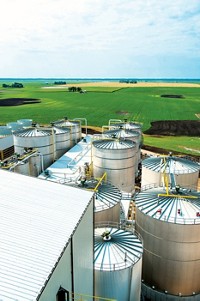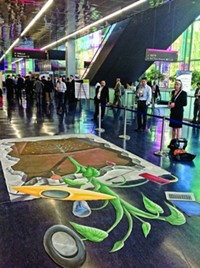Advertisement
Grab your lab coat. Let's get started
Welcome!
Welcome!
Create an account below to get 6 C&EN articles per month, receive newsletters and more - all free.
It seems this is your first time logging in online. Please enter the following information to continue.
As an ACS member you automatically get access to this site. All we need is few more details to create your reading experience.
Not you? Sign in with a different account.
Not you? Sign in with a different account.
ERROR 1
ERROR 1
ERROR 2
ERROR 2
ERROR 2
ERROR 2
ERROR 2
Password and Confirm password must match.
If you have an ACS member number, please enter it here so we can link this account to your membership. (optional)
ERROR 2
ACS values your privacy. By submitting your information, you are gaining access to C&EN and subscribing to our weekly newsletter. We use the information you provide to make your reading experience better, and we will never sell your data to third party members.
Business
Pragmatism Rules At Gathering Of Biobased Chemical Leaders
World Congress on Industrial Biotechnology attendees tout smart decision-making, strong partnerships
by Melody M. Bomgardner
August 3, 2015
| A version of this story appeared in
Volume 93, Issue 31

The table of conference-goers was in agreement: The themes of the 2015 World Congress on Industrial Biotechnology were “pragmatic optimism” and “stick-to-itiveness.” It was the last session of this year’s gathering in Montreal, organized by the Biotechnology Industry Organization, a trade group.
Given the current low prices of fossil-fuel-based materials, attendees and presenters were pleased—or perhaps relieved—to still be working toward a biobased economy in the 12th year of the show. Biobased chemical facilities are still being planned, and partnerships continue to form. But there was a detectable wistfulness for the early days when start-ups targeted huge markets and investors were enthusiastic and generous.
Self-described pragmatic optimist Jonathan S. Wolfson, chief executive officer of algal oil firm Solazyme, counseled patience. He told the audience that although his company is 12 years old, it is still in its early days. He also reflected on the firm’s original strategy to make fuel from algae—a plan that has taken a backseat to a focus on lower volumes of pricey oils for food, cosmetic, and industrial uses.
“With petroleum at less than $60 per barrel, fuels cannot be Solazyme’s main product,” Wolfson acknowledged. Several biobased chemical firms reported they are targeting small niches—sustainable leather, feed for aquaculture, replacements for bisphenol A—whereas others hope to succeed by selling into established intermediate chemical markets.
But attendees also testified that in moving toward higher-value specialty and intermediate chemicals and away from fuels and basic chemicals, their companies have traded one set of challenges for another. For example, biobased succinic acid maker BioAmber has identified a host of markets where its product adds value, but it is finding it hard to elbow into the supply chain.
“We can supply the push with our development work in different products, but getting that pull from customers is not easy,” admitted Anne Waddell, BioAmber’s vice president of government affairs. “Even with applications experience, getting in is a daunting task.”
BioAmber partner Woodbridge Group, a maker of automotive parts, puts polyurethane components through more than 20 quality and performance standards before it will sell them. It could take years to link together a chain that would start with biobased succinic acid and end with a finished car, although Waddell said one goal of the partnership is to streamline the process.
Biobased product makers are also fielding pointed questions from well-versed investors and customers who seek details such as whether an industrial microbe is genetically modified or who want to see cost models for little-used feedstocks such as waste biogas.
“We get a lot of economic questions—like about the price of our methane,” said Mark Herrema of biopolymer firm Newlight Technologies. “They know it’s not a free feedstock.” Herrema said Newlight will build a 50 million-lb-per-year facility in the Midwest to make a polyhydroxyalkanoate-based thermoplastic it calls AirCarbon.
Indeed, despite the challenges, companies presenting at the world congress said they are smart enough to survive and thrive. One piece of evidence is that manufacturing facilities are coming on-line, and new ones are being built. For example, BioAmber’s long-awaited succinic acid plant is scheduled to start up in the fall in Sarnia, Ontario.
Another facility should be producing sooner—Italy’s GFBiochemicals announced at the show that it has begun production at its 5 million-lb levulinic acid plant in Caserta, Italy. Levulinic acid—made directly from biomass, not from sugar—can replace petroleum-derived ingredients for crop protection products, coatings, solvents, and fuels, the firm said.
Also this year, construction will begin on Verdezyne’s 30 million-lb diacids plant in Malaysia. The company’s first product will be dodecanedioic acid, made by yeast fermentation of vegetable oils. Dodecanedioic acid can be used to make nylon and other polymers.
Verdezyne’s vice president for R&D, Tom Beardslee, said his team came to Montreal to update collaborators on the firm’s progress and meet with potential customers. “As you get closer to commercialization, people want to know about it—the conversation can get serious when you can send them a ton of material,” Beardslee told C&EN.
For newer companies, the show was an opportunity to publicize important partnerships. Dave Law, the CEO of Liquid Light, was on hand to celebrate his firm’s new deal with Coca-Cola. Liquid Light’s 20 employees are developing an electrochemical cell that transforms CO2 from ethanol plants and other sources into chemicals such as ethylene glycol, an input for Coca-Cola’s biobased PlantBottle.
“We are thrilled to have this agreement; it will provide both technical and financial support and be the backbone of the company for years to come,” Law said. Prior to joining the company, Law worked at Bayer for 33 years. “At a start-up, it can be refreshing to make decisions quickly,” he noted. “Still, we have to be selective. To succeed we must focus on one good prospect.”




Join the conversation
Contact the reporter
Submit a Letter to the Editor for publication
Engage with us on Twitter